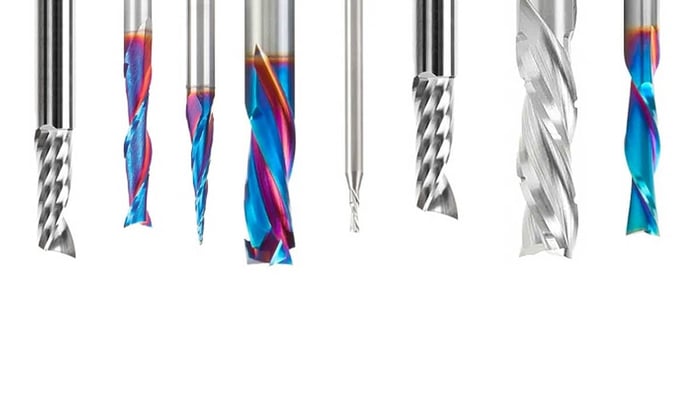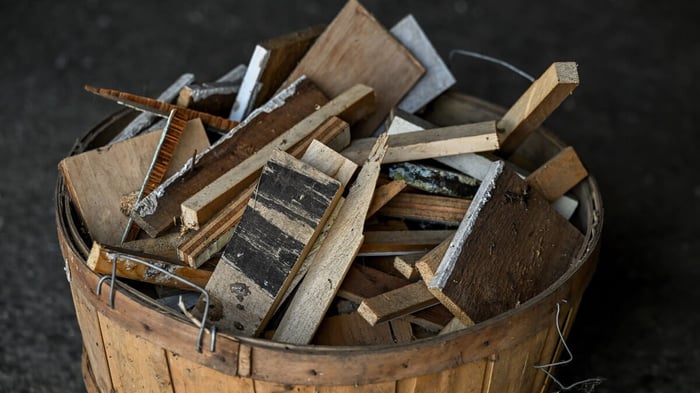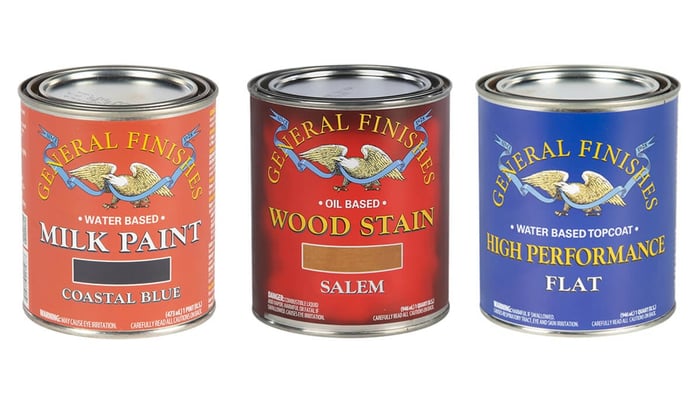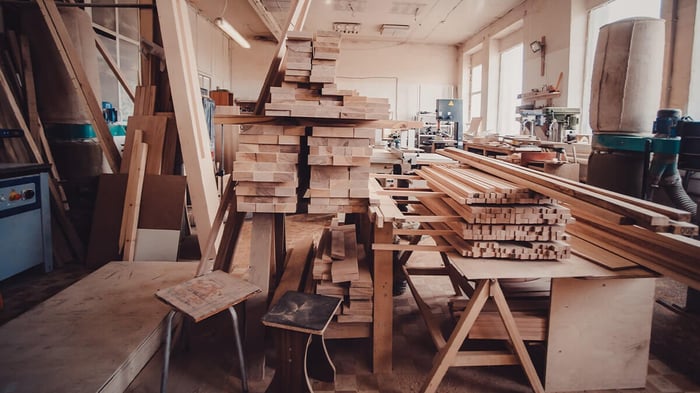
How to Avoid Router Tear-Out
What is Tearout?
"Tear out" when routing wood is a common issue that occurs when the router bit pulls or lifts chunks of wood fiber away from the surface or edge of the workpiece, rather than cutting cleanly through it. This can leave a rough, splintered surface or edge that detracts from the quality of the finished piece. Several factors can cause or contribute to tearout:
- Grain Direction: Wood fibers run in a specific direction along the grain. Routing against the grain increases the likelihood of catching and lifting these fibers, causing tear out.
- Router Bit Sharpness: Dull router bits are more likely to tear wood fibers instead of cutting them cleanly. Keeping bits sharp is crucial for minimizing tear out.
- Feed Rate and Speed: Feeding the wood too fast or too slow relative to the router's speed can cause tear out. A too-fast feed rate doesn't give the bit enough time to cut cleanly, while a too-slow rate can burn the wood or cause excessive friction, both of which can lead to tear out.
- Type of Router Bit: Certain types of bits are more prone to causing tear out, especially if they have fewer cutting edges or are not designed for the type of cut being made. For example, straight bits can cause more tear out compared to spiral bits, which slice through the wood, reducing the chances of lifting fibers.
- Bit Speed: The speed of the router bit itself can also affect tear out. If the speed is too high or too low for the type of wood and the specific cutting operation, it can increase the likelihood of tear out.
- Supporting the Workpiece: Not adequately supporting the wood near the cut can lead to vibration or movement, which increases the risk of tear out. Using push blocks or clamps to securely hold the workpiece can help.
- Quality of Wood: Some types of wood are more prone to tear out due to their grain structure, hardness, or condition (e.g., whether the wood is dry or wet). Softer woods and those with irregular grain patterns (like figured woods) are often more susceptible to tear out.
Minimizing tear out involves addressing these factors by using sharp bits, choosing the appropriate bit for the material and type of cut, maintaining proper feed rates and bit speeds, supporting the workpiece effectively, and being mindful of the wood's grain direction.
Dull Router Bit
A dull router bit is a primary culprit behind tearout issues in woodworking, as it struggles to cleanly cut through the wood fibers, leading to splintering and rough edges.
When a router bit becomes dull, it loses its sharpness, causing it to crush and tear the wood fibers instead of smoothly slicing through them. This not only results in a jagged and uneven surface but also compromises the overall quality of the woodworking project.
Maintaining sharp router bits is crucial for achieving clean and precise cuts without tearout. Regularly sharpening or replacing router bits is a simple yet vital aspect of tool maintenance that can significantly enhance the outcome of your woodworking endeavors.
Incorrect Feed Direction
Choosing the wrong feed direction while operating a router can exacerbate tearout, causing the wood fibers to tear rather than cut cleanly along the desired path.
When it comes to woodworking tasks such as routing, mastering the feed direction is crucial for achieving smooth and tear-free cuts. By selecting the appropriate feed direction, woodworkers can effectively control the way in which the router blade interacts with the wood surface, minimizing the likelihood of tearout.
Understanding the grain orientation of the wood and adjusting the feed direction accordingly can significantly enhance the quality of the cuts and contribute to a more professional finish. Implementing strategic tearout prevention techniques, such as using sharp router bits and maintaining a steady feed rate, further aids in ensuring precise and clean cuts during routing operations.
Improper Grain Orientation
Ignoring the natural grain orientation of the wood surface can result in tearout issues when using a router, as cutting against the grain leads to splintering and tear-prone edges.
Considering the direction of the grain is crucial for woodworking projects to achieve clean cuts and smooth edges. Aligning the router with the wood grain helps the cutting blades move smoothly along the natural fibers, reducing the risk of tearout. By following the wood grain direction, woodworkers can enhance the precision of their cuts and minimize the chances of splintering. This simple adjustment in technique can make a significant difference in the overall quality of the finished piece, showcasing the importance of proper grain orientation in woodworking.
Using the Wrong Router Bit
Selecting an inappropriate router bit for the task at hand can lead to tearout problems, as the wrong cutting edge profile may not effectively slice through the wood fibers.
This can result in splintering, chipping, or rough edges on the wood surface, compromising the overall finish of your woodworking projects. To prevent tearout, it is crucial to match the correct router bit profile to the specific wood type, density, and grain direction you are working with.
Different cutting edge styles, such as straight, spiral, or helical, offer varying levels of effectiveness depending on the application. Understanding these distinctions and selecting the appropriate tool for the job not only enhances precision but also contributes to smoother and cleaner cuts.
How to Prevent Tearout When Using a Router?
Preventing tearout during router operations involves employing proper techniques such as using a sharp router bit and ensuring the correct feed direction to achieve clean and tear-free cuts.
Adjusting the router speed to match the wood density and grain direction is crucial in minimizing tearout. It’s important to secure the workpiece firmly with clamps or a router table to prevent unnecessary vibrations. Utilizing a backing board can also reduce tearout by providing support to the wood fibers as the router bit cuts through. Regularly inspecting and maintaining the router bit, as well as using the appropriate safety gear such as eye protection and hearing protection, are essential practices for safe and effective woodworking."
Use a Sharp Router Bit
Ensuring the router bit remains sharp is crucial in tearout prevention, as a keen cutting edge cleanly slices through the wood, resulting in smooth finishes and minimal tearout.
Regular maintenance practices play a vital role in sustaining the sharpness of router bits. Cleaning off resin buildup, honing the cutting edge, and checking for any signs of wear are essential steps. Proper storage in protective cases or racks can also prevent damage. Sharpening router bits periodically using a specialized sharpening tool is necessary to maintain their effectiveness.
Neglecting maintenance not only affects the quality of finishes but can also lead to overheating and premature wear of the bit. Investing time in upkeep saves both money and effort in the long run.
Adjust the Feed Direction
Adopting the correct feed direction, whether with a handheld router or on a router table, plays a pivotal role in minimizing tearout and ensuring the wood fibers are cleanly cut in the intended direction.
- When using a handheld router, controlling the feed direction can be more challenging as it requires steady hand movement and precise control to avoid tearout.
- With a router table, the process is more stable and allows for a smoother feed direction, resulting in cleaner cuts.
Using accessories like featherboards and push sticks can further enhance the control over the feed direction, making it easier to achieve tearout-free routing and maintaining the quality of the woodworking project.
Pay Attention to Grain Orientation
Respecting the grain direction of the wood surface is essential for tear-free routing, as aligning the router with the natural grain prevents tearout and promotes smooth, tear-free cuts.
This attention to detail becomes even more critical when working on intricate woodworking projects where precision is key. By following the natural grain pattern, woodworkers can not only achieve tear-free cuts but also enhance the overall aesthetics of their creations. Improper grain orientation can lead to splintering, chipping, and rough edges, diminishing the quality of the final piece. Understanding how different wood species react to cutting forces based on their grain direction empowers craftsmen to execute cleaner and more professional-looking finishes.
Choose the Right Router Bit
Selecting the appropriate router bit for the specific wood material being worked on is crucial in tearout prevention, as different wood types require suitable bit profiles to minimize tearout.
In woodworking, the choice of router bit can significantly impact the overall finish and quality of your project. Birch, for example, requires a different type of router bit compared to oak due to its grain structure.
By understanding the characteristics of the wood you are working with, you can select the most suitable router bit to ensure clean cuts and smooth edges. The right router bit not only prevents tearout but also enhances the precision and efficiency of your routing tasks, underscoring the importance of material-specific bit selection in woodworking projects.
What Are Some Techniques to Avoid Tearout?
Incorporating specialized techniques like climb cutting and using backer boards can significantly reduce tearout in woodworking projects, ensuring clean and precise cuts without splintering.
These innovative strategies are particularly useful when working with materials prone to tearout, such as plywood and certain types of hardwoods. By employing climb cutting, woodworkers can minimize chip-out by moving the router bit against the direction of rotation. Utilizing backer boards provides essential support to the workpiece, preventing tearout on the edges and ensuring a smooth finish. Incorporating these tear-free woodworking techniques can elevate the quality of your projects and result in professional-level craftsmanship.
Climb Cutting
Climb cutting is an effective technique for minimizing tearout, as it involves moving the router in the reverse direction of the bit rotation to achieve smoother cuts and reduce splintering.
This woodworking method is particularly beneficial when working with materials prone to tearout, such as plywood or figured wood. By utilizing climb cutting, woodworkers can significantly decrease the likelihood of unsightly splinters and rough edges, resulting in a cleaner and more professional finish.
This approach not only enhances the overall aesthetics of the project but also ensures a safer and more enjoyable woodworking experience, making it a valuable skill for both novice and experienced craftsmen.
Backer Boards
Using backer boards can provide added support and stability during routing tasks, effectively reducing tearout by preventing wood fibers from splintering and ensuring tearout-free projects.
By sandwiching the workpiece between the backer board and the router blade, woodworkers can achieve clean and precise cuts without risking tearout. This simple yet crucial technique is especially beneficial when working with materials prone to splintering, such as plywood or veneer. Backer boards act as a sacrificial layer, absorbing the force of the cutting tool and minimizing the risk of tearout, ultimately resulting in smoother edges and professional-looking finishes.
Utilizing the appropriate router bit attachments can further enhance the efficiency and effectiveness of backer boards in achieving flawless woodworking outcomes.
Tape or Veneer
Applying masking tape or veneer to the wood surface before routing can act as a protective barrier, controlling tearout and ensuring clean cuts by stabilizing the wood fibers.
This preemptive measure is especially crucial when working with delicate wood species prone to tearout, such as maple or cherry. By securely adhering masking tape along the cutting path or applying a thin layer of veneer, woodworkers can significantly reduce the risk of tearout, resulting in smoother edges and a more professional finish.
These techniques not only protect the wood surface but also enhance precision and accuracy during the routing process, proving to be invaluable strategies for tearout control in woodworking projects.
Using a Router Table
Utilizing a router table offers enhanced stability and control during routing tasks, facilitating tear-free woodworking by providing a secure platform for precise cuts and smooth finishes.
This tool not only helps in minimizing tear-out, but also increases efficiency by allowing woodworkers to work with greater accuracy and speed. By utilizing router accessories such as featherboards and push sticks, woodworkers can further enhance safety and precision while working on intricate details. The adjustable fence on a router table enables woodworkers to make consistent cuts and intricate designs, leading to flawless results. The versatility of a router table also allows for the creation of various joinery techniques like dadoes, rabbets, and box joints, expanding the possibilities for woodworking projects.
What to Do If Tearout Still Occurs?
Even with preventive measures, if tearout occurs, remedial actions such as sanding the affected area, filling the tearout with appropriate fillers, or even rerouting the section can salvage the woodworking project.
In cases where tearout persists despite initial efforts, consider utilizing a finer grit sandpaper to delicately smooth out the damaged fibers, ensuring a seamless finish. Opting for high-quality wood fillers specifically designed for tearout repair can aid in restoring the wood's integrity.
For more extensive tearout issues, strategically re-routing the affected section by adjusting the woodworking tools' cutting direction might be necessary to minimize tearout and enhance the project's overall aesthetic appeal. These corrective measures, coupled with meticulous woodwork finishing techniques, can lead to a successful project completion despite encountering tearout challenges.
Sanding
Sanding the affected area post-tearout can help smooth out rough edges and imperfections, providing a remedial solution for managing tearout and restoring the wood surface's finish.
This crucial step in tearout management involves using woodworking tools such as sandpaper or a power sander to refine the surface by gradually removing layers of wood until a smoother texture is achieved. By carefully sanding the area, woodworkers can eliminate tearout marks, splinters, and inconsistencies, ensuring that the final finish appears flawless. Proper sanding not only improves the aesthetics of the project but also enhances the overall durability and longevity of the woodwork by creating a uniform and polished surface.
Selecting the right grit of sandpaper is essential to effectively address tearout without causing further damage to the wood.
Filling the Tearout
Filling the tearout with suitable fillers or putties offers a practical approach to eliminating tearout damage, restoring the wood surface to its original form and texture for a seamless finish.
By using woodworking tools such as chisels or scrapers to carefully remove any loose wood fibers around the tearout area, you can create a clean surface for the filler application. Once the area is prepped, select a filler that matches the wood species and color for optimal blending. Apply the filler generously to fill the gaps, ensuring it is level with the surrounding surface. After allowing the filler to dry and cure as per manufacturer's instructions, sand the area gently to achieve a smooth and even finish. This meticulous process not only repairs the damage but also enhances the overall aesthetics of the woodwork.
Re-routing
In cases of severe tearout, re-routing the affected section using proper techniques and precautions can be an effective method to avoid tearout and achieve the desired woodworking outcome.
- By carefully analyzing the direction of the wood grain and adjusting the cutting speed of the router, woodworkers can minimize tearout significantly.
- Utilizing sharp router bits specifically designed to reduce tearout, such as compression bits or spiral upcut bits, can also greatly enhance the routing process.
- Prioritizing router safety measures, such as wearing protective gear and ensuring a stable workpiece setup, is crucial in preventing accidents and achieving tearout-free results.
- Practicing on scrap wood before routing the actual project piece can help refine the technique and mitigate potential tearout issues.
Frequently Asked Questions
How to Avoid Tearout When Using a Router (Woodworking Tool)
1. What is tearout and why is it important to avoid when using a router?
Tearout refers to the fibers of wood being pulled or torn out instead of being cleanly cut, resulting in rough and uneven edges. It is important to avoid tearout when using a router because it can ruin the appearance and quality of your woodworking project.
2. How can I prevent tearout when routing across the grain?
To prevent tearout when routing across the grain, use a sharp router bit with a high number of teeth. You can also try routing in multiple shallow passes instead of one deep pass, and using a backing board to support the wood fibers.
3. Is it better to route with or against the grain to avoid tearout?
It is generally better to route with the grain to avoid tearout, as the router bit will be cutting with the direction of the wood fibers. However, if routing against the grain is necessary, taking extra precautions such as using a sharp bit and making multiple shallow passes can help reduce tearout.
4. Are there specific router bits or techniques that can help prevent tearout?
Yes, there are several router bits and techniques that can help prevent tearout. Spiral upcut bits, for example, are designed to pull wood fibers away from the workpiece, reducing the chances of tearout. Additionally, using a router with a slow speed and making shallow cuts can also help prevent tearout.
5. How important is it to keep the router bit sharp to avoid tearout?
Keeping the router bit sharp is crucial in avoiding tearout. Dull bits tend to crush and tear the wood fibers instead of cutting through them cleanly, resulting in tearout. Be sure to regularly sharpen or replace your router bits to ensure clean and smooth cuts.
6. What should I do if I still experience tearout despite taking precautions?
If you still experience tearout despite taking precautions, there are a few things you can try. You can try using a different type of router bit, adjusting the speed of your router, or changing the direction in which you are routing. If all else fails, you may need to sand or plane down the affected area to smooth out any rough edges caused by tearout.





